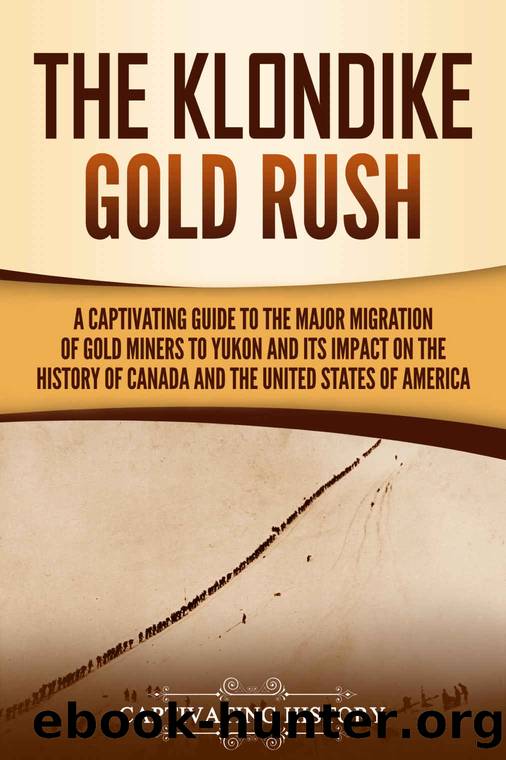The Klondike Gold Rush: A Captivating Guide to the Major Migration of Gold Miners to Yukon and Its Impact on the History of Canada and the United States of America (Exploring Canadaâs Past) by Captivating History

Author:Captivating History [History, Captivating]
Language: eng
Format: azw3, epub
Published: 2022-07-21T00:00:00+00:00
Chapter 3 â Lakes, Rivers, and Rapids
Chilkoot and White Pass Trails to Lake Bennett, where they merged. From there, much of the journey was by boat. The railroad, as you read, was not built until after the gold rush was over.
Soerfm, CC BY-SA 3.0 <https://creativecommons.org/licenses/by-sa/3.0>, via Wikimedia Commons; https://commons.wikimedia.org/wiki/File:Dyea-skagway-map.jpg
In hindsight, the term ârushâ to describe the hunt for gold in the Yukon might be a bit of a misnomer. Yes, over 100,000 people ârushedâ to the north from New York, Toronto, Quebec, Chicago, and many other places, but once they got to Alaska and then Canada, things slowed to a crawl.
For us today, itâs almost impossible to understand the monotony, not to mention the backbreaking labor, of the journey to the Yukon. There were no phones; any contact with the outside world came from the occasional telegraph message to a Mounted Police post or a town like Dawson City. Even then, it might take days or even weeks for news to reach the people on the trails. Newspapers were prized. In Pierre Bertonâs The Klondike Fever, he relates that one man who had lived in the Klondike for some time as a trapper had saved about fifty old newspapers from months and even years before the rush, which he loaned out to miners who were desperate for something to read.
The monotony was matched by the anticipation of finding gold. In some ways, the men of the Klondike Gold Rush were similar to men at war, except in reverse. In war, most men think the next man on the line will âget it,â but not him. In the Klondike, many men believed they would surely find enough gold to come out of the adventure ahead of the game, while their neighbors would find nothing. Even the wisdom of experienced prospectors did not dissuade themâno one wants to believe they gave up everything they had for a slim chance at finding gold. Thus, they were willing to suffer the privations, hard work, and monotony of the trails.
Once they made it to Long Lake (on the Chilkoot Trail) or Lake Bennett (on White Pass Trail), most Stampeders chose to make boats by hand. The men often carried oakum, which the American Heritage Dictionary describes as âloose hemp or jute fiber, sometimes treated with tar, creosote, or asphalt, used chiefly for caulking seams in wooden ships and packing pipe joints.â The men also had to carry pitch, which is essentially tar or sometimes pine resin. These items were used in the making of wooden ships and boats. They also carried nails, not just for odd jobs that might come up but to build the boats that would hopefully take them to their destination near the Klondike. At the southern ends of Long Lake or Summit Lake, large settlements went up, and trees by the hundreds (possibly thousands) came down.
Download
The Klondike Gold Rush: A Captivating Guide to the Major Migration of Gold Miners to Yukon and Its Impact on the History of Canada and the United States of America (Exploring Canadaâs Past) by Captivating History.epub
This site does not store any files on its server. We only index and link to content provided by other sites. Please contact the content providers to delete copyright contents if any and email us, we'll remove relevant links or contents immediately.
Navigation and Map Reading by K Andrew(5111)
Spare by Prince Harry The Duke of Sussex(5072)
Tuesdays with Morrie by Mitch Albom(4692)
Cracking the GRE Premium Edition with 6 Practice Tests, 2015 (Graduate School Test Preparation) by Princeton Review(4224)
Machine Learning at Scale with H2O by Gregory Keys | David Whiting(4179)
Never by Ken Follett(3790)
Goodbye Paradise(3728)
What It Really Takes to Get Into Ivy League and Other Highly Selective Colleges by Hughes Chuck(3696)
Harry Potter and the Prisoner of Azkaban (Book 3) by J. K. Rowling(3304)
Fairy Tale by Stephen King(3220)
Pledged by Alexandra Robbins(3132)
Kick Ass in College: Highest Rated "How to Study in College" Book | 77 Ninja Study Skills Tips and Career Strategies | Motivational for College Students: A Guerrilla Guide to College Success by Fox Gunnar(3075)
A Dictionary of Sociology by Unknown(3031)
Sapiens and Homo Deus by Yuval Noah Harari(2987)
Reminders of Him: A Novel by Colleen Hoover(2951)
The Social Psychology of Inequality by Unknown(2940)
Graduate Admissions Essays, Fourth Edition: Write Your Way into the Graduate School of Your Choice (Graduate Admissions Essays: Write Your Way Into the) by Asher Donald(2876)
Will by Will Smith(2792)
Zero to Make by David Lang(2726)
